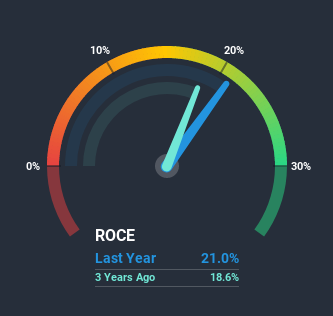Will Billington Holdings (LON:BILN) Become A Multi-Bagger?

Want to participate in a short research study? Help shape the future of investing tools and earn a $40 gift card!
If you're looking for a multi-bagger, there's a few things to keep an eye out for. Firstly, we'll want to see a proven return on capital employed (ROCE) that is increasing, and secondly, an expanding base of capital employed. This shows us that it's a compounding machine, able to continually reinvest its earnings back into the business and generate higher returns. And in light of that, the trends we're seeing at Billington Holdings' (LON:BILN) look very promising so lets take a look.
Understanding Return On Capital Employed (ROCE)
If you haven't worked with ROCE before, it measures the 'return' (pre-tax profit) a company generates from capital employed in its business. To calculate this metric for Billington Holdings, this is the formula:
Return on Capital Employed = Earnings Before Interest and Tax (EBIT) ÷ (Total Assets - Current Liabilities)
0.21 = UK£5.9m ÷ (UK£50m - UK£22m) (Based on the trailing twelve months to December 2019).
So, Billington Holdings has an ROCE of 21%. In absolute terms that's a very respectable return and compared to the Construction industry average of 18% it's pretty much on par.
View our latest analysis for Billington Holdings
Historical performance is a great place to start when researching a stock so above you can see the gauge for Billington Holdings' ROCE against it's prior returns. If you want to delve into the historical earnings, revenue and cash flow of Billington Holdings, check out these free graphs here.
What The Trend Of ROCE Can Tell Us
We like the trends that we're seeing from Billington Holdings. The data shows that returns on capital have increased substantially over the last five years to 21%. The company is effectively making more money per dollar of capital used, and it's worth noting that the amount of capital has increased too, by 94%. So we're very much inspired by what we're seeing at Billington Holdings thanks to its ability to profitably reinvest capital.
On a side note, Billington Holdings' current liabilities are still rather high at 43% of total assets. This can bring about some risks because the company is basically operating with a rather large reliance on its suppliers or other sorts of short-term creditors. While it's not necessarily a bad thing, it can be beneficial if this ratio is lower.
Our Take On Billington Holdings' ROCE
To sum it up, Billington Holdings has proven it can reinvest in the business and generate higher returns on that capital employed, which is terrific. Since the stock has only returned 30% to shareholders over the last five years, the promising fundamentals may not be recognized yet by investors. Given that, we'd look further into this stock in case it has more traits that could make it multiply in the long term.
Billington Holdings does have some risks though, and we've spotted 1 warning sign for Billington Holdings that you might be interested in.
If you'd like to see other companies earning high returns, check out our free list of companies earning high returns with solid balance sheets here.
This article by Simply Wall St is general in nature. It does not constitute a recommendation to buy or sell any stock, and does not take account of your objectives, or your financial situation. We aim to bring you long-term focused analysis driven by fundamental data. Note that our analysis may not factor in the latest price-sensitive company announcements or qualitative material. Simply Wall St has no position in any stocks mentioned.
Have feedback on this article? Concerned about the content? Get in touch with us directly. Alternatively, email editorial-team@simplywallst.com.

